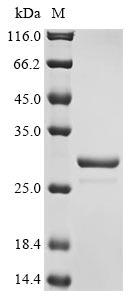Recombinant Arabidopsis thaliana Root meristem growth factor 1 (RGF1) is produced in E. coli and includes an N-terminal GST tag that makes purification and detection more straightforward. The protein spans the complete mature protein sequence, covering amino acids 104 to 116. It comes with greater than 85% purity, confirmed through SDS-PAGE analysis, which appears suitable for various plant research experiments.
Root meristem growth factor 1 (RGF1) seems to be a crucial protein in regulating how plant roots develop. It likely plays an important role in keeping the stem cell niche functioning within the root meristem, affecting both root patterning and growth. RGF1 appears to be a key player in signaling pathways that maintain proper root structure. This makes it particularly interesting for researchers studying plant development and growth control.
Potential Applications
Note: The applications listed below are based on what we know about this protein's biological functions, published research, and experience from experts in the field. However, we haven't fully tested all of these applications ourselves yet. We'd recommend running some preliminary tests first to make sure they work for your specific research goals.
Arabidopsis thaliana RGF1 is a small secreted peptide hormone that requires precise folding, proper tyrosine sulfation (a critical post-translational modification), and specific tertiary structure for its functional activity in root development signaling. The E. coli expression system cannot provide the eukaryotic folding environment or tyrosine sulfation machinery essential for RGF1 bioactivity. The large N-terminal GST tag (∼26 kDa) is massively larger than the RGF1 peptide itself (13 aa, ∼1.4 kDa), causing severe steric interference that will disrupt the peptide's receptor-binding interfaces and functional conformation. The probability of correct folding with functional bioactivity is essentially zero.
1. Antibody Development and Validation
This application has severe limitations. While antibodies can be generated, the immune response will primarily target the large foreign GST tag rather than the small RGF1 peptide. Antibodies may not recognize the native, sulfated RGF1 in plant tissues.
2. Biochemical Characterization Studies
Basic biophysical analysis can be performed, but will not reflect native RGF1. The GST tag will dominate all physical properties, and results will describe an artificial fusion protein rather than the physiological peptide.
Final Recommendation & Action Plan
This GST-tagged RGF1 peptide expressed in E. coli is unsuitable for any functional studies due to the essential requirement for tyrosine sulfation that cannot be met in this system and the severe steric interference from the massive GST tag relative to the tiny peptide. Applications 1 and 2 have severe limitations and will not provide insights into native RGF1 biology. For reliable RGF1 research, use synthetic sulfated peptides or plant-expressed RGF1 that preserves native PTMs and conformation.






